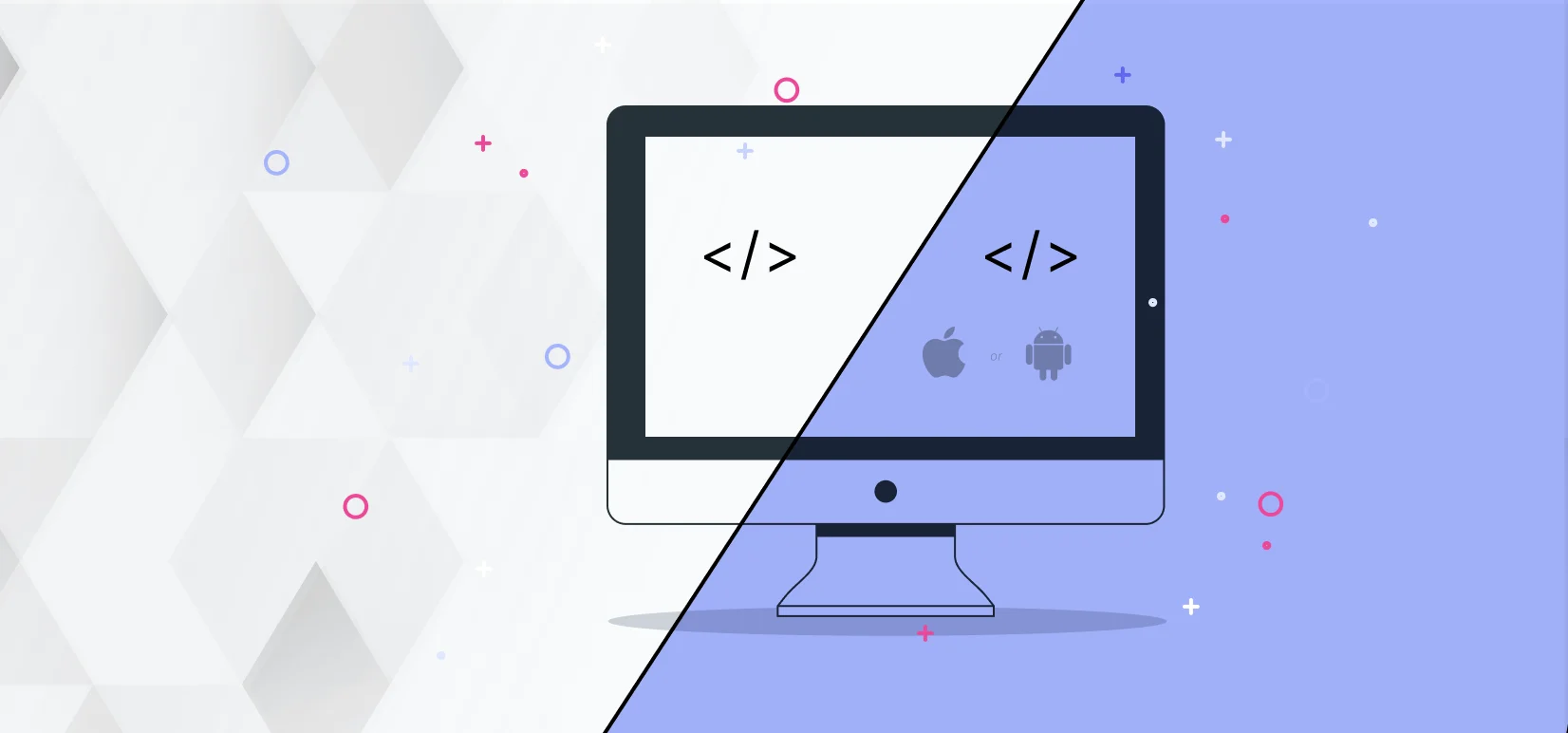- JAMstack
Flutter vs. React Native: Everything You Need to Know


If you’re a mobile developer looking to build a mobile application today, choosing the right framework for your project can be a daunting task. And as you surely already know, one of the most crucial factors to take into account while developing a software product today is using the appropriate tool for the job.
React Native and Flutter are two popular mobile app development frameworks that have gained significant traction in recent years. Both frameworks offer developers the ability to create high-performance, cross-platform mobile applications that can be deployed on Android and iOS devices.
In this article, we will compare and contrast these two frameworks and discuss their key features, their pros and cons, and their suitability for different types of projects. And by the end of the article, you will have a better understanding of the differences between React Native and Flutter to make an informed decision on which framework is right for your project.
What Is React Native?
React Native is an open-source framework by Facebook for building native and cross-platform mobile applications using React, a JavaScript library for building user interfaces. It allows developers to create a single codebase that can be used to build apps for both iOS and Android platforms, thereby providing a consistent user experience across devices.
React Native uses native components and APIs to create a truly native experience while still offering the flexibility and power of a modern, reactive programming model.
Features of React Native
If you’re considering adopting React Native for your projects, here are some of its interesting features and capabilities you should know.
Cross-Platform Compatibility: The ability to use a single codebase on many mobile platforms offers a lot of advantages in app development. React Native lets you run a single codebase for multiple platforms, such as iOS, web, and Android. Such an advantage is crucial in terms of minimizing development costs and time to market.
Open-Source and Community-Driven: React Native is free to use and can be modified, and is constantly being developed by a large community of contributors who provide support and guidance for other developers.
Performance: React Native ships with a Just-in-time (JIT) compiler and uses native components rather than web-based components to ensure fast and efficient performance on mobile devices.
Live Reloading: Live or hot reloading enables React Native developers to apply changes to their source code and see the changes in real-time without having to refresh the app or experience loss of state manually.
Reusable Components: The modular approach of React Native allows developers to build reusable components that can be easily incorporated into different parts of an app. This provides benefits such as fast development times and awesome developer experience.
Easy to Learn: React Native uses JavaScript and React, making it easier for developers with those skills to pick up. It also uses a declarative programming style, which is easy to understand and allows developers to quickly become proficient in building mobile apps.
What Is Flutter?
Flutter is an open-source mobile app development framework by Google for building beautiful, natively compiled, and multi-platform (mobile, web, and desktop) applications from a single codebase. It primarily uses the Google-owned Dart programming language and runs in a Dart virtual machine, which includes a Just-in-time compiler for fast compilation times.
When creating a Flutter application, you'll often find yourself working with widgets as a Flutter developer. Widgets are the fundamental building blocks of any Flutter app.
A widget is an immutable description of part of a user interface that describes how views and layouts should look like given their current configuration and state. Widgets are to Flutter what components are to React.
Features of Flutter
Cross-Platform Compatibility: Like React Native, Flutter allows you to use a single codebase for multiple platforms, such as Android, iOS, and desktop, to save time, resources, and effort.
Widgets: A wide range of use cases are covered by the comprehensive selection of widgets that Flutter offers. This allows developers to create highly customized and polished user interfaces without having to write complex code.
Rich Development Environment: Flutter offers a rich development environment, including an integrated development environment (IDE), a powerful command-line interface (CLI), and a wide range of tools and plugins for testing and debugging.
Native Performance: Flutter apps are compiled to native code, which means they run smoothly and efficiently as most native frameworks, such as Kotlin or Swift, on both Android and iOS devices.
Strong Community Support: Flutter has a large and growing community of developers who share tips and advice and support each other on forums and social media. This makes it easy for developers to get help and feedback as they work on their projects.
Flutter vs. React Native: Head-to-Head Comparison
In this section, in order to help you make an informed decision when selecting a framework for your project, we'll look at the similarities and differences, advantages and disadvantages of both mobile app development frameworks.
But before we dive in, let’s take a moment to understand how both technologies work and their underlying architecture.
React Native runs two different isolated JavaScript threads under the hood. One thread lets you run your app on any native platform, such as iOS or Android, and the other runs the business logic of your application. Between the threads is a bridge that lets the two threads communicate and share resources or data.
This multi-layer architecture is sometimes said to contribute to React Native’s slower performance when compared to Flutter.
Flutter, at its core, has a Flutter engine that is built on top of C++ and Skia, a 2D graphics rendering library, and Dart, a virtual machine for a garbage-collected object-oriented language that hosts them in a shell.
The Flutter engine is a portable runtime responsible for the low-level implementation of Flutter’s core API, including graphics, text layout, file and network I/O, accessibility, and plugin architecture.
Similarities Between React Native and Flutter
Flutter and React Native are both popular open-source frameworks for mobile app development. While the two frameworks are separate projects with distinct architectures, they do share some similarities.
Cross-platform compatibility is one feature shared between both Flutter and React Native. The two frameworks allow you to run a single codebase across multiple platforms, thereby saving you time and resources.
In addition, both frameworks have a large community of developers who are constantly sharing ideas and maintaining the frameworks for adaptability. This flexibility makes them more reliable and future-proof since anyone can access the source code and make improvements.
Next, we’ll make a head-to-head comparison between React Native and Flutter in terms of performance, code reusability, learning curve, ecosystem, nd many more.
Advantages of React Native over Flutter
Performance
React Native has better performance for certain types of apps, such as those that require a lot of computation or have complex user interfaces. It integrates better with native platform features and APIs, which can be useful particularly in developing platform-specific functionality.
This makes it a better choice for developing gaming apps, augmented reality apps, or other resource-demanding applications.
Code Reusability
Another major advantage of React Native over Flutter is code reusability. React Native ships with its own set of APIs that can be used across the iOS and Android platforms. Flutter apps are usually platform-specific, that is, sometimes it’s not possible to use certain iOS widgets or plugins on Android and vice versa.
Learning Curve
React Native is built on top of JavaScript, a popular and widely-used programming language with a large and vibrant developer community. This can make it much simpler for your team to work with, reduce the learning curve, as well as for you to identify and hire developers who have the necessary expertise for your project.
Developer Ecosystem
React Native has a larger developer ecosystem than Flutter. React Native was released to the public in 2015, unlike Flutter, which was introduced in 2017. React Native has a larger ecosystem of contributors, companies, and individuals, third-party libraries, and plugins than Flutter. This means there are likely to be ready-made solutions to some of the problems or ideas you might have while developing your applications.
Advantages of Flutter over React Native
Performance
We already mentioned that React Native is better than Flutter when it comes to the development of certain apps. But generally, in terms of performance, Flutter delivers better performance and development speed benefits than React Native as it uses its own high-performance rendering engine to draw widgets directly to the screen. This capability lets you experience a near-native performance in your applications.
Greater Platform Support
In contrast, to React Native, which only supports the Android and iOS mobile platforms, Flutter is compatible with mobile, web, and desktop platforms such as Windows, macOS, Linux, and so on. This is a huge advantage that contributes to Flutter being widely adopted by teams and businesses today.
Preference
Among the most popular mobile app development frameworks, Flutter is probably the most popular and well-loved. It has over 140,000 likes on GitHub, more than React Native, which has 106,000 likes. Also, in a 2021 survey conducted by Stack Overflow, Flutter outshines React Native as the most loved mobile application development framework by developers.
Developer Experience
Flutter and React Native both have great documentation and user guides. However, the Flutter documentation is more organized, straightforward, and informative than React Native's, which is somehow disorganized but still user-friendly.
Differences Between React Native and Flutter
React Native and Flutter are projects from two distinct companies, namely Facebook (now Meta) and Google, respectively. This means that there are likely to be variances between the two technologies that make them distinct from one another.
One key difference between the two frameworks is the programming language they use. Flutter uses the Dart programming language, while React Native uses JavaScript. Both languages have their own pros and cons, so the choice of which one to use can depend on a developer's personal preference and experience.
Another major difference between Flutter and React Native is the level of customization and control that each framework offers. Flutter provides a wide range of customizable widgets, allowing developers to create highly customized user interfaces.
React Native, on the other hand, uses native components, which can provide better performance but may require more work to customize.
Furthermore, React Native only provides a few base components to get started with while everything else you need is managed and provided by the open-source community through a package manager like npm. Flutter, on the other hand, is bootstrapped with a huge widget library and is managed by Google developers themselves. It also has a package manager named Pub that hosts open-source and official libraries for your applications.
Overview of Flutter vs. React Native
Flutter and React Native are both popular choices for building mobile applications. Both frameworks have their strengths and weaknesses, and either one can be a good choice for building a cross-platform mobile app. Overall, the choice between Flutter and React Native will depend on your preferences and the specific needs of your project.
If you're still unsure and would like to know more about the scenarios in which any of these frameworks would be appropriate for your use cases, then you should continue reading to find out.
When to Use React Native Over Flutter?
Now that you have a basic understanding of the capabilities and architecture of both React Native and Flutter, let’s go through some examples of where you might want to use React Native over Flutter.
E-commerce - If you’re building an e-commerce store, then you may want to consider React Native. This choice will be based mainly on preference since both React Native and Flutter can be used to build e-commerce applications.
Social Networks - React Native is a good choice for social networking apps largely because it provides access to native device features and APIs, such as the camera, geolocation, and push notifications, which are essential and useful in any social networking app.
Real-Time and Streaming Applications - Video playback, user authentication, and real-time communication are a few of the many capabilities that can be built into streaming apps using React Native's extensive ecosystem of third-party modules and components. You can leverage these capabilities to build real-time or streaming applications that can handle heavy data without sacrificing performance.
For your inspiration, here are a few examples of popular applications that are built with React Native.
Facebook - It’s not surprising that the popular social media network is built on top of a framework it developed itself. Facebook lets users share photos and posts, and engage with friends and family or communities.
Tesla - If you own a Tesla, then you are very likely to have used the Tesla mobile application as a communication tool with your vehicles, energy products and so on. The application leverages TypeScript with React Native to deliver a top-notch experience for its users.
Coinbase - Coinbase, a cryptocurrency exchange platform, utilizes React Native capabilities to provide selling, buying, and storage for its users. Coinbase provides its userbase access to real-time data and analytics and handles a ton of data all at once.
Microsoft Teams - Teams is a video conferencing application that supports streaming and real-time chat. It makes use of the native capabilities of React Native to handle concurrency and other resource-intensive features.
Walmart - The Walmart mobile app is a good example of an e-commerce app that leverages React Native native components’ performance and cross-platform capabilities to provide a best-in-class shopping experience for its customers.
In summary, if you’re looking to build a mobile application in any category, such as e-commerce, social networking, real-time data analytics, or streaming, then you should consider going for React Native. You can also check out a more comprehensive list of applications that are built with React Native in this showcase.
When to Use Flutter Over React Native?
We have already seen the various kinds and categories of apps in which React Native would be a great choice over Flutter. Flutter, on the other hand, is no doubt the most popular choice for crafting elegant UIs and creating bespoke animations across mobile platforms.
Flutter is more capable of handling animations better than React Native, all thanks to the Flutter engine and huge repository of widgets. If you're developing an app that fits into any of the following categories below, you should definitely think about adopting Flutter.
Desktop and Web Apps - One of the major advantages of Flutter over React Native is its ability to allow a single codebase for creating web and desktop applications. React Native in its prime was limited to the Android and iOS platforms (although recently it now added support for desktops, which is maintained by Microsoft). But Flutter, since its creation, takes it further, allowing you to use the same codebase for desktop or web applications.
Rich Animations and UIs - Flutter may be a better option than React Native when it comes to designing stunning animations and intricate user interfaces. You may design highly effective and beautiful UIs that are user-friendly and intuitive by leveraging the vast widget library provided by Flutter and the Skia graphics engine.
Complex Applications - According to its developers, Flutter is designed to help developers easily achieve a constant 60fps. This level of performance allows you to create apps that are responsive, start at blazing speed, and run effectively while handling millions of records.
The following are examples of popular applications built with Flutter.
Alibaba Group - Xianyu, a Chinese eCommerce company that relies on the Alibaba e-commerce system, uses Flutter to develop its mobile app, which handles its underlying complex architecture and provides its users with a unique shopping experience.
So Vegan - So Vegan is a recipe app that takes advantage of Flutter’s huge widget library to create a unique and beautiful design experience for its user base.
eBay - The eBay mobile app allows consumers to browse and purchase goods and services on eBay, an online marketplace. This app leverages Flutter's cross-platform capability to provide its users with an experience that is consistent between iOS and Android.
You can browse an additional list of applications that are built with Flutter from this showcase.
Flutter vs. React Native: Is React Native Better than Flutter?
In all honesty, it's difficult to conclude whether React Native or Flutter is better. Both frameworks are great in their own right, and they each have their own strengths and weaknesses. Their performance will depend on so many factors, such as the size of the application you’re building, the users’ devices, the number of third-party libraries used, and so many others.
In this case, the experience will be a critical factor in determining which framework will best suit your needs. It may also be a good idea to try out both frameworks and see which one works best for your projects.
Finally, the ideal option between React Native and Flutter will ultimately depend on your project's unique requirements and objectives, as well as the knowledge and preferences of the development team.
Download the best JavaScript frameworks guide to answer the 'which JavaScript framework to use for your next project?'

